
Augustin Pyramusde Candolle was a Swiss botanist. René Louiche Desfontaines launched de Candolle's botanical career by recommending him at a herbarium. Within a couple of years de Candolle had established a new genus, and he went on to document hundreds of plant families and create a new natural plant classification system. Although de Candolle's main focus was botany, he also contributed to related fields such as phytogeography, agronomy, paleontology, medical botany, and economic botany.

Linaria vulgaris, the common toadflax, yellow toadflax or butter-and-eggs, is a species of flowering plant in the family Plantaginaceae, native to Europe, Siberia and Central Asia. It has also been introduced and is now common in North America.
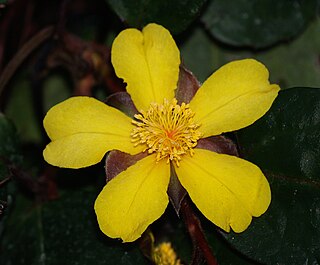
Hibbertia dentata, commonly known as toothed guinea flower, trailing guinea flower or twining guinea flower, is an ornamental plant in the family Dilleniaceae native to the east coast of Australia. Found in woodland, it is a trailing or twining vine with leaves with several small 'teeth' on the margins and bright yellow flowers in early spring. It adapts readily to cultivation and can be grown as a pot plant. The species was first described in 1817.

Lechenaultia linarioides, commonly named yellow leschenaultia, is a species of flowering plant in the family Goodeniaceae and is endemic to near-coastal areas in the west of Western Australia. It is a sprawling subshrub with many tangled branches, narrow, crowded, rather fleshy leaves, and yellow and deep pink to purplish red flowers.
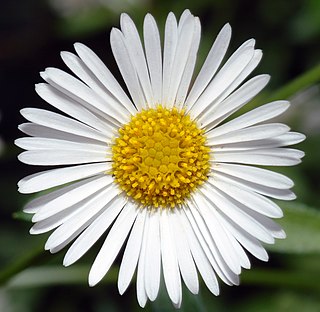
Erigeron karvinskianus, the Mexican fleabane, is a species of daisy-like flowering plant in the family Asteraceae, native to Mexico and parts of Central America.

Anigozanthos flavidus is a species of plant found in Southwest Australia. It is member of the Haemodoraceae family. It is commonly known as the tall, yellow, or evergreen, kangaroo paw. The specific epithet, flavidus, refers to the yellow flowers of this plant.

Acacia pyrifolia, commonly known as ranji bush is a shrub that is endemic to the north of Western Australia.

Pomaderris intermedia, commonly known as lemon dogwood, is a species of flowering plant in the family Rhamnaceae and is endemic to south-eastern Australia. It is a shrub with hairy stems, elliptic to egg-shaped leaves, and clusters of yellow flowers.

Linaria dalmatica is a herbaceous, short-lived perennial plant native to western Asia and southeastern Europe that has become a weed in other areas. The family this plant now belongs to is the Plantaginaceae Family. Previously, it belonged to the Scrophulariaceae (Figwort) family. Its common names include Balkan toadflax, broadleaf toadflax, and Dalmatian toadflax. Linaria dalmatica has unique yellow flowers with an orange center that draw individuals to purchase them to display in their gardens. The distribution of L. dalmatica to North America can be attributed to use as a fabric dye, folk remedies and as an ornamental plant. However, it is now classified as a weed in both Canada and the U.S.
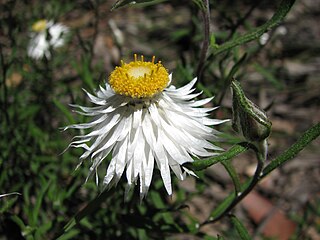
Helichrysum leucopsideum, commonly known as satin everlasting, is a flowering, perennial herb in the family Asteraceae. It is grows in all states of Australia except Queensland and the Northern Territory. It has white, terminal flower heads and narrow, woolly leaves.
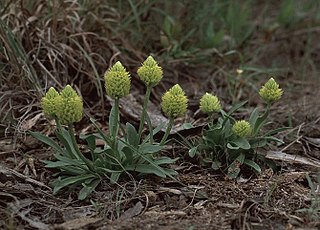
Senega nana, commonly known as candyroot or low bachelors' buttons, is a small species of herbaceous plant native to the south-eastern United States. The root has a sweet liquorice flavor when it is chewed, but it is usually hidden underground until the plant flowers. The seeds of candyroot are dispersed by ants.
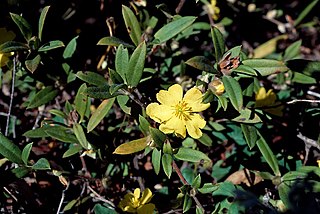
Hibbertia saligna is a species of flowering plant in the family Dilleniaceae and is endemic to the east coast of New South Wales. It is an erect or spreading shrub with narrow elliptic to lance-shaped leaves with the narrower end towards the base and relatively large yellow flowers with 20 to 35 stamens arranged around three glabrous carpels.

Olearia decurrens, commonly known as the clammy daisy bush, is a species of flowering plant in the family Asteraceae and is endemic to arid, inland Australia. It is a glabrous, sticky, twiggy shrub with narrow egg-shaped to linear leaves sometimes with toothed edges, and white and yellow, daisy-like inflorescences.

Hibbertia diffusa, commonly known as wedge guinea flower, is a species of flowering plant in the family Dilleniaceae and is endemic to south-eastern Australia. It is a prostrate to low-lying shrub with glabrous stems, egg-shaped to lance-shaped leaves with the narrower end towards the base, and bright yellow flowers arranged on the ends of branchlets, with twenty to twenty-five stamens arranged around two or three carpels.

Pyrrhopappus pauciflorus, commonly known as smallflower desert-chicory, Texas false dandelion or Texas dandelion, is a species of flowering plant in the family Asteraceae. It is native to the southern United States and northern Mexico. It is a weedy annual found in prairies, clay soils and disturbed habitats such as fields and sidewalks.

Thesium humifusum is a species of hemiparasitic flowering plant in the family Santalaceae found in western Europe and north-western Africa, known as bastard-toadflax.

Hibbertia linearis is a species of flowering plant in the family Dilleniaceae and is endemic to eastern Australia. It is a shrub with linear to oblong or egg-shaped leaves and yellow flowers with 15 to 25 stamens arranged around the three carpels.
Olearia elaeophila is a species of flowering plant in the family Asteraceae and is endemic to the south-west of Western Australia. It is a small shrub with scattered linear leaves, and white or blue and yellow, daisy-like inflorescences.
Olearia hygrophila, commonly known as swamp daisy or water daisy, is a species of flowering plant in the family Asteraceae and is endemic to a restricted part of North Stradbroke Island in south-eastern Queensland. It is a shrub with slender stems, linear leaves and white and yellow, daisy-like inflorescences.

Olearia quercifolia, commonly known as oak-leaved olearia, is a species of flowering plant in the family Asteraceae, and is endemic to the Blue Mountains in New South Wales. It is a shrub with elliptic to egg-shaped leaves with the narrower end towards the base, and white and yellow daisy flowers.



















